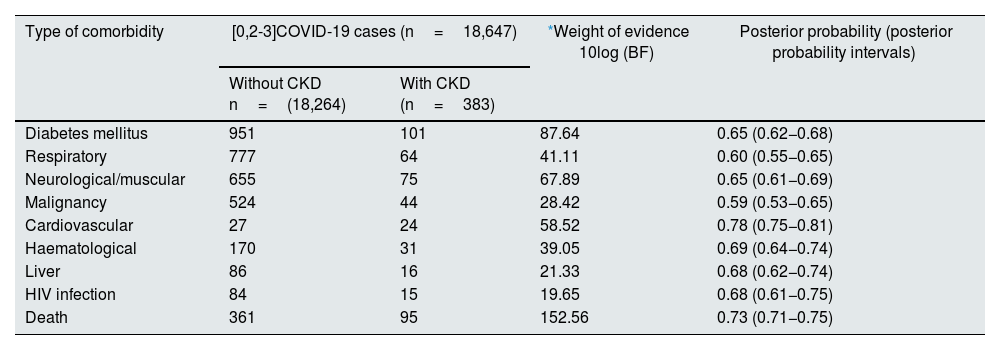The clinical research reported in this journal use the standard framework of frequentist statistics based on hypotheses of significance (P<.05). This method leads to a dichotomisation of the results as “significant” or “insignificant”, which require the evaluation of the statistical hypotheses.1 The use of the Bayesian approach is therefore important as an improved manner of drawing statistical conclusions from clinical data, as it facilitates the answer to the question, “What is the likelihood of the effect being conclusive according to the data?”, which provides greater validity to significant conclusions. One of the best-known methods is the Bayes factor (BF), which estimates the likelihood of one hypothesis in relation to the other based on the data (for example, null hypothesis vs alternative hypothesis).1,2 This enables the weight of the evidence to be estimated (10 times the decimal logarithm of the BF), which is useful for clinical decision-making on significant findings (Table 1).3,4
Bayesian A/B testing values.
| Type of comorbidity | [0,2-3]COVID-19 cases (n=18,647) | *Weight of evidence 10log (BF) | Posterior probability (posterior probability intervals) | |
|---|---|---|---|---|
| Without CKD n=(18,264) | With CKD (n=383) | |||
| Diabetes mellitus | 951 | 101 | 87.64 | 0.65 (0.62−0.68) |
| Respiratory | 777 | 64 | 41.11 | 0.60 (0.55−0.65) |
| Neurological/muscular | 655 | 75 | 67.89 | 0.65 (0.61−0.69) |
| Malignancy | 524 | 44 | 28.42 | 0.59 (0.53−0.65) |
| Cardiovascular | 27 | 24 | 58.52 | 0.78 (0.75−0.81) |
| Haematological | 170 | 31 | 39.05 | 0.69 (0.64−0.74) |
| Liver | 86 | 16 | 21.33 | 0.68 (0.62−0.74) |
| HIV infection | 84 | 15 | 19.65 | 0.68 (0.61−0.75) |
| Death | 361 | 95 | 152.56 | 0.73 (0.71−0.75) |
Replication of clinical results is recommended to validate the practical credibility of such findings using Bayesian inference, useful in different statistical tests (Student's t test, odds ratios, linear regression or ANOVA),1–3 and in diagnostic measurements such as area under the ROC curve (AUROC), because such estimates are convertible to an effect size, for example, correlation coefficient (r).5
Another Bayesian model of interest is the Bayesian A/B test to contrast two similar clinical events considering the assignment of prior distributions and the control of such sample data6 according to the logarithmic odds ratio scale (logOR<0, logOR>0), more suitable for simultaneous evaluation with a normal distribution.7 The contrast of variation between both proportional groups is represented by the BF. This is useful for different studies that include participants with and without the clinical event of interest, as, for example, it enables us to evaluate the rates of comorbidity, admissions, medication or death from COVID-19. The application of this Bayesian model helps provide greater precision of the rates of difference in data both nationally and internationally, where more realistic probabilities are reported by transforming the Bayesian effect size obtained: OR to probability=OR/(OR+1) and its respective intervals. Such estimates make it possible to determine how likely it really is that participants with the clinical outcome of interest have such an occurrence. Replication using this Bayesian method is an alternative for reassessing comparative hypotheses of research with binary data or frequencies that do not report mean values or standard deviation.
For this letter, we considered the data reported from a study in this journal8 on a sample of patients with COVID-19 infection in different comorbidities, in which there were significant differences between two groups: patients with and without chronic kidney disease (CKD). Our aim was to determine the incidence of the outcome of comorbidity and the weight of the evidence (Table 1).
Table 1 shows that all the significant results had estimates of decisive evidence (>20) in favour of COVID-19 patients with CKD who had a comorbid condition of (logOR>0) compared to the other group without this disease (logOR<0). The results with the greatest weight of evidence were the CKD comorbid groups with diabetes mellitus and neurological/muscular disease, both events with a 65% risk probability in contrast to the other non-CKD groups. Being a patient with COVID-19, cardiovascular disease and CKD meant a higher risk of incidence (78%) compared to the other event with an evidence value of 58.52. Another risk group was those with COVID-19, haematological disorders and CKD with 69% occurrence and a decisive weight of 39.05. A risk assessment of the mortality event was also carried out. The Bayesian A/B test reported a weight of evidence of 152.56 (decisive) with a higher probability of occurrence of 73%, the intervals of which refer to a minimum of 71% and a maximum of 75% risk in COVID-19 patients with CKD. Statistical replication using the Bayesian A/B test has demonstrated its utility in other COVID-19 research9,10 and is essential in the development of future biomedical trials.7,10






